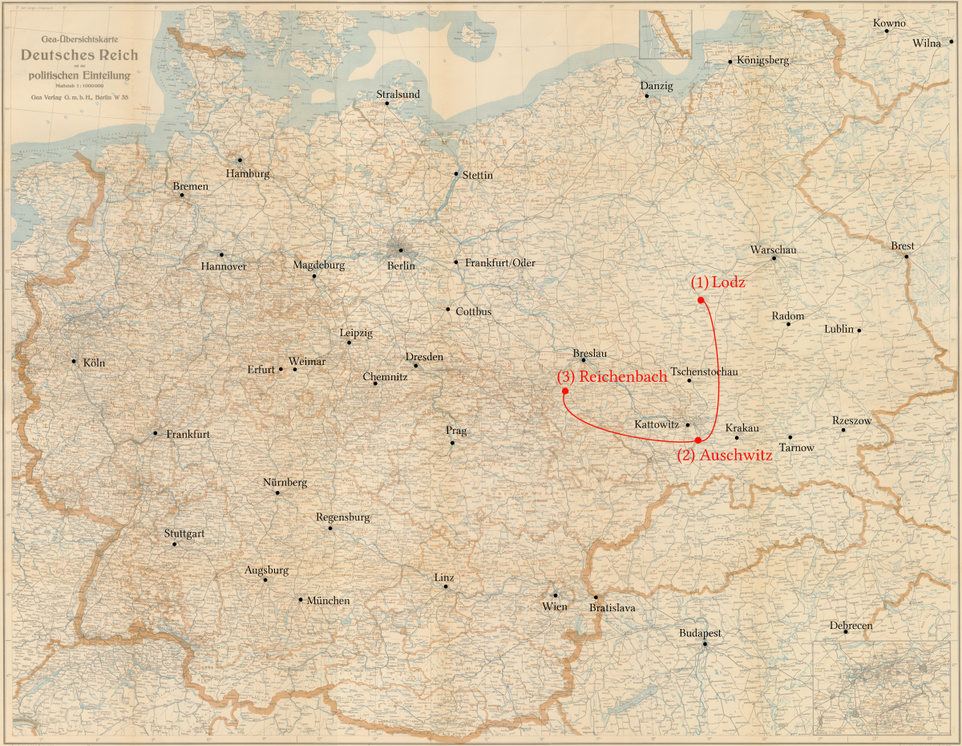The Biography of Henia Weissblum, née Wassermann, Lodz
Short biography and stations of her persecution
- born on 20 Occtober 1914 in Kossow/Poland; née Wassermann; widowed Jaegermann
- 1939 Lodz
- September 1939 Jewish star, forced labor Lodz
- 5 January 1940 to August 1944 Lodz ghetto
- November 1941(?) Deportation of husband and child
- May 1943 Lodz ghetto, Dworskagasse 6, works in the food department
- October 1943 she makes children's toys for export to Germany
- august 1944 1 week in Auschwitz/Birkenau concentration camp
- Groß-Rosen concentration camp/Reichenbach sub camp (Hagenau factory)
- 8 May 45 Liberation by the Russian army
- Lodz
- Fall 1946 to May 1947 Displaced Persons Camp Bad Salzschlirf near Fulda,
- 11 July 1947 Journey with "Exodus" from Sete (France) to Israel
- 18 July 1947 Boarding of the "Exodus" by the British navy
- 22 August 1947 to 8 September 1947 Return transport to Hamburg, Displaced Persons Camp Emden,
- 14 August 1948 Israel.
Henia Weissblum lost her parents, her husband, her child and three brothers.
So I had to endure the suffering of the Lodz ghetto, then Birkenau concentration camp, ZAL Reichenbach - Hagenau factory.
During this time I was very often ill, had high fevers, severe colds, joint and bilious inflammations, angina, dysentery, typhus and other illnesses and had to keep on working, despite the fever, in order to avoid extermination. The violent measures to which I was subjected during the National Socialist persecution were of particular severity and duration, and to which my husband, my child Mosche, my parents, 3 brothers and family also fell victim, have shaken my health and my nervous system to such an extent that I cannot overcome the effects of these experiences.
The liberation reached me in a state of complete mental and physical exhaustion and illness.
Affidavit dated July 7, 1965.
Life before Persecution
Before the war, I was a life-affirming, strong and healthy woman. I lived happily in Lodz with my husband, Leib Jägermann, and my child Mosche. My husband was a tailor and earned about 450 Zl. a month.
Affidavit dated July 7, 1965
At the outbreak of the war in September 1939, I was living with my first husband Leib Jaegermann and my one-year-old son Mosche in Lodz at 11 Novemberstrasse 61.
Affidavit dated September 14, 1956
Lodz ghetto
All Jews were immediately ordered by the Germans to wear a yellow armband, then the yellow patch with the Star of David visible on their chest and back. Our freedom of movement was restricted and we were made to do forced labor, we had to sweep streets, clean toilets, etc. Everyone was concentrated in the so-called ghetto, and on May 1, 1940, the ghetto was declared closed. Leaving without authorization was punished with death. Jewish police ensured that order was maintained inside under the commandant Rosenblatt. The Jewish elder was called Chaim Rumkowski and the German BIBOW was the commandant of the ghetto. The living conditions in the ghetto were very poor, as it was located in the BALUTI slum. In November 1941 our family, my husband's child and I, were torn apart in an action. I was rescued by a German official who was an acquaintance of Bibow. My husband and child were deported and I never saw them again. I was taken to his apartment in Petrokomskastr. every day under strict guard and had to do the hardest and most humiliating work for his household. In May 1943 I was transferred to Dworskagasse 6, where I worked in the food department. From October 1943 I worked in the manufacture of toys, which were sent to Germany.
Affidavit dated 14.9.1956
After the persecution began, I was forced to perform extremely hard and humiliating forced labor that was beyond my strength, in hunger, cold, wetness, abuse and in constant fear of being destroyed.
Auschwitz and Reichenbach
In August 1944, I was sent to Birkenau concentration camp along with many other ghetto inmates. After a week, we were transferred from this concentration camp to ZAL Reichenbach in locked wagons. We were led to work day after day under guard; the construction of the "Hagenau" factory, the building of bunkers and fortifications and were also guarded by SS women in this camp. One of the Jewish elders tormented us a lot. We were liberated from this camp by the Russian army on May 8, 1945.
Affidavit from September 14, 1956
After the War
After the liberation I went to Lodz to the Kibbutz Misrachi and married my present husband Zische Weissblum. In 1946 we went to Germany and stayed there in the Fulda DP camp even after January 1, 1947. We traveled to Israel on the illegal ship "Exodus" and were forcibly returned to Germany by the British to the EMDEN-KASERNE DP camp. Our daughter Ima Waisblum was born there on November 30, 1947, in the hospital in Sandhorst in the Aurich district. We immigrated to Israel on August 14, 1948.
Affidavit dated September 14, 1956
Notes
Further Sources
----
Office for Compensation
Darmstadt
Notes
----
Picture Credits
----
